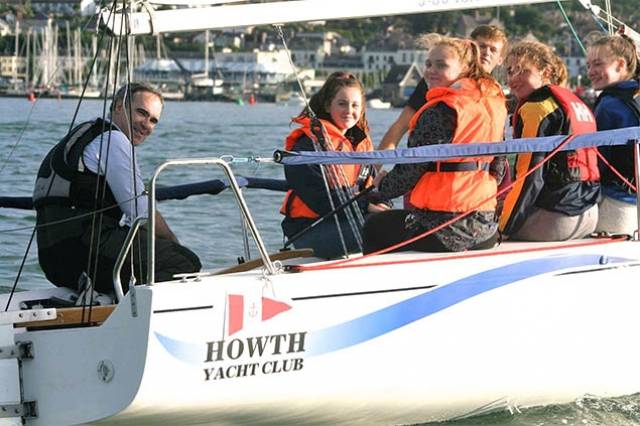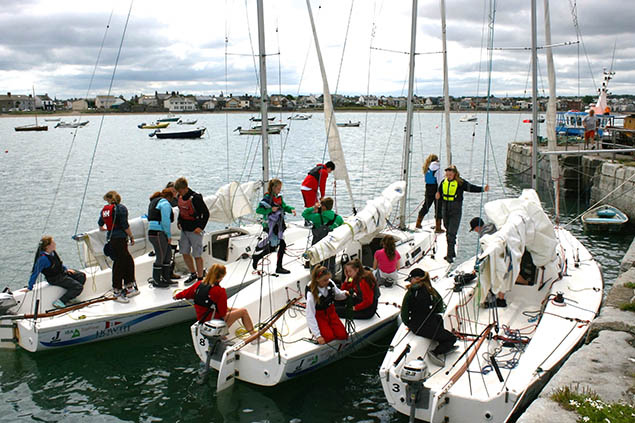While the headlines and public attention for much of the summer were dominated by the acrimonious Brexit vote in Britain and the extremes of the Olympic Games in Rio de Janeiro, out beyond a narrow sandspit on a secretive peninsula east of Ireland, a special project was being finalised. This has seen the local sailing club benefit both from the Brexit fallout, and the general increased goodwill towards sailing in Ireland which Olympic success has generated. W M Nixon finds that his home-from-home of Howth Yacht Club has been doing some remarkable things while everyone else – himself included - was looking elsewhere.
You’ve heard the story about the three Howthmen who went across to England a few weeks ago to buy four J/80s, and came back with five? We hadn’t either. But all we know is that every time recently when we looked along the hard-standing on the waterfront at Howth Yacht Club, there seemed to be a couple of extra J/80s about the place. Soon there were five. And they all looked distinctly newer than the eight long-used J/80s of the SailFleet flotilla of the ISA, four of which are regularly stored out the back of the Howth club when they’re not in action.
All was revealed last weekend. The background is that Howth YC had undertaken to look after the ISA’s SailFleet flotilla of eight J/80s when the national authority began its severe slimming process three years ago. The club uses four of them at any one time in a leasing programme from the ISA for its own training purposes, but rotates the boats for their periods of non-use to implement an “equalisation process”. And of course, all eight are made available for the use of the ISA in national events like the Helmsmans Championship, wherever such events may be held.
However, since 2013 when Breda Dillon was Commodore, the Howth club has also had in place the allocation of a Sports Council capital grant for buying keelboats for training, the grant of €77,000 being conditional on HYC raising an extra €23,000 to provide a round sum of €100,000.
It was also conditional on being spent before 31st July 2016. Logic would seem to suggest that they would buy the ISA boats, four of which were on lease until 31st December 2016 anyway. But it wasn’t as simple as that. Those boats were bought with a government grant in the first place. There were all sorts of potential problems with VAT and whatever. And a bidding war against other clubs was an additional unknowable.
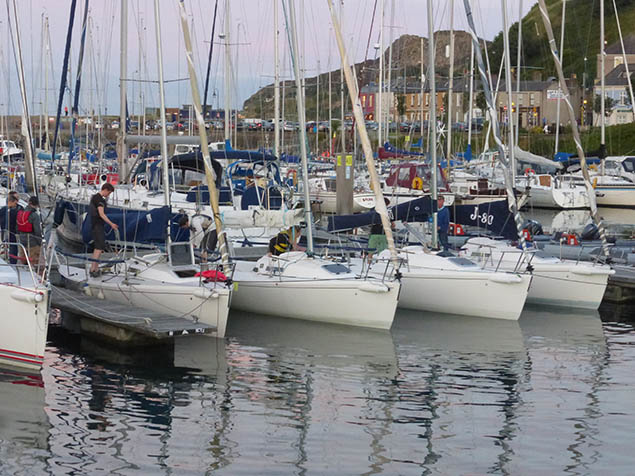
Yet the Howth men knew that for a multi-purpose boat which can play a key role in getting new people into sailing, or encouraging lapsed sailors back again, the J/80 was and is and will long continue to be the best boat for the job. It’s one of the very few sportsboat types which qualify for a European offshore certificate. And it is also entitled to an IRC rating. Thus in the Irish context, you can race it as a One-Design, but you are also eligible for open ICRA competition.
In addition to that, the J/80 is a very likeable knockabout boat, real fun to sail with a cockpit big enough to take significant numbers of beginners out for good yet educational times afloat, while still being a very serious racing proposition for crews of three to five. Thus the feeling in Howth was that increasing the national stock of J/80s by whatever means would be good for Irish sailing anyway.
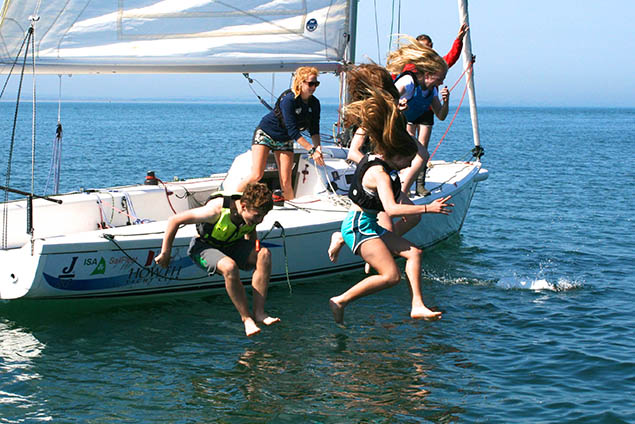 While the J/80 was designed primarily as a performance boat with racing a priority, in Howth they find many other uses. Photo: Brian McDowell
While the J/80 was designed primarily as a performance boat with racing a priority, in Howth they find many other uses. Photo: Brian McDowell
But though the J/80 has been a major part of the sailing scene in Europe only since a new production facility for the boat was set up in France in 2002, the design actually first appeared in America in 1992. And with the remorseless new product initiative which drives J Boats as it drives any other successful company, in late 2012 J Boats introduced the J/70, more of an outright sportsboat than the J/80, but still with a little cabin – albeit a much smaller one.
Thus for those with a taste for novelty and fashion trends, the J/70 will have been seen as the successor to the J 80. But many would reckon that the J 80 continues to be a significant brand in her own right, as she has that cherished European offshore cert. And while her cabin is minimal, it does offer significantly roomier overnight space than the J/70, as the J/80 is almost 9% larger in every way than the newer boat, an addition in size which adds a very useful bit of beef to her potential for multi-purpose functions.
That said, in the last couple of years the advent of the J/70 has tended to freeze or even reduce the price of used J/80s. For the Howthmen sitting on a war chest of €100,000 which had to be spent before the end of July 2016, the availability of top-quality used J/80s in the Solent area presented something of a dilemma. They could either enter into a lengthy tender process to take over the ISA J/80s, or else they could send an expeditionary force to the south of England to snap up four quality J/80s in a neat and clinical operation.
Four was the key number, as experience in the past three years has shown HYC that the total SailFleet flotilla of eight boats is too much for one club to handle comfortably, but anything less than four boats would be less than the required critical mass. Four boats was the absolute minimum, but as Howth YC also have two J/24s in their successful U25 Keelboat Training Squad, including the Enda O Coineen-donated Ireland’s Eye Kilcullen (Ireland’s Eye are knitwear manufacturers in nearby Baldoyle), they had some flexibility of movement in finalizing boat numbers.
In fact, in recent years the Howth club has become so dedicated to introducing people to sailing and training generally that the noted offshore racer Kieran Jameson, a General Committee member who heads the HYC key “Vessels Committee”, finds his group running a club-owned training fleet of thirty dinghies including Optimists, Toppers, 420s, and Laser Vagos. But in addition to dinghies, the Howth sailors are very strongly of the opinion that keelboats also have an important role to play in getting people started sailing, thus at any one time the club has had six “training keelboats” – the four J/80s being used at any one time plus the hotly-competed pair of J/24s – playing an active role.
The feedback from HYC Marine Manager Brian McDowell during the 2016 season has been particularly encouraging regarding the popularity of the J/80s as much for non-racing activity as for racing/training. Ireland’s many cruising enthusiasts will be delighted to hear that day cruises to places as diverse as Skerries, Dalkey Island, and Dun Laoghaire rating high on the list of favourite activities aboard J/80s amongst both younger and adult newcomers to sailing alike.
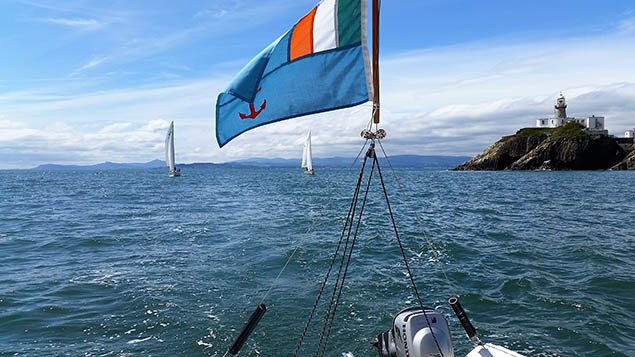 Cruising enthusiasts will be pleased to hear that trainee sailors at Howth particularly enjoy using the J/80s for cruises-in-company along the local coast. The photo above shows them returning round the Baily after a visit to Dalkey Island and Dun Laoghaire, while (below) one of the most popular destinations has been Skerries, which involves a 14 miles coastal passage with proper navigation and pilotage exercises. Photos Brian McDowell
Cruising enthusiasts will be pleased to hear that trainee sailors at Howth particularly enjoy using the J/80s for cruises-in-company along the local coast. The photo above shows them returning round the Baily after a visit to Dalkey Island and Dun Laoghaire, while (below) one of the most popular destinations has been Skerries, which involves a 14 miles coastal passage with proper navigation and pilotage exercises. Photos Brian McDowell
So acquiring the best possible J/80s within the budget was clearly the way to go. After Vice Commodore Emmet Dalton had burnt the midnight oil and the fibre optic cables in ensuring that everything in the original capital equipment grant application of 2013 was still valid, Commodore Berchmans Gannon and his committee confirmed Kieran James as “Concept and Logistics Director” with his three man “Solent Procurement Task Force”, and off they went with the 31st July deadline looming.
All this may sound very formalised, but as anyone who is familiar with Howth will know, there are times when you’ll find yourself in the midst of what seems to be a convivial gathering, yet it’s actually an open-ended official planning meeting. The club takes much of its internal communication style from its oldest class, the Howth 17s of 1898, which have managed to stay together for 117 years while apparently relying largely on telepathy for in-class information. And as all the many people involved in the J/80 acquisition programme were old friends who frequently sail together as shipmates, new ideas and understandings of how best the project might best move forward could emerge in all the most unlikely places at unexpected times.
The three man squad was imbued with enthusiasm, as Kieran Jameson is a total J/80 fan. So he already had the class’s used-boat scene sussed out in some detail in the south of England where he is well known, and with him he brought his keen sub-committee member Johnny Wormald, while third hand was a very important man when money is being spent, HYC Honorary Treasurer David Sargent.
They’d two very busy days around the Solent finalizing deals on four J/80s of the required standard in a time of financial turbulence. After the Brexit vote, the Pound Sterling had plummeted against the Euro, but their feeling (quite rightly as it turned out) was that even though it was still falling, it might be about to bounce back a bit any time soon, so there was some urgency to their work.
With no slackening of the pace, the buying job was done, and then with four boats satisfactorily secured, they were having a celebratory lunch in the RORC’s Royal Corinthian clubhouse in Cowes. But David Sargent couldn’t stop being the money man. He’d been working the screen for the numbers and the exchange rate, and in mid-meal he came up with the news that they’d hit the dealing floor on the sweet spot, in fact if they wished there was still enough in the kitty to buy a fifth boat.
Well, why not? A quick phone call home got the cheerful instruction to go right ahead. And another quick phone call ensured the fifth boat was theirs before news had spread from the Isle of Wight that three mad Irishmen were on the prowl around the Solent ready to throw good money at proper quality used J/80s.
Moving up to five boats from four may not seem such a big deal. But in fact it puts you across a significant threshold as many clubs such as Dublin Bay SC will recognize five boats as a valid class eligible for its own start, but not four. Yet thanks to Brexit, as former HYC Commodore Brian Turvey has since put it: “We landed sunny side up” – five boats and all of them good ones.
But now the challenge was to keep things moving along. Everyone had been fuelled with the excitement of the chase. Yet with high summer and its holiday plans upon them, a busy sailing programme in full swing, and the all-dominant Olympics taking over all sailing thinking for two weeks in mid-August, the challenge for all involved was to get the five boats safely back to Howth and moved into the next stage of the plan, for it was essential that the boats be in active use as soon as possible.
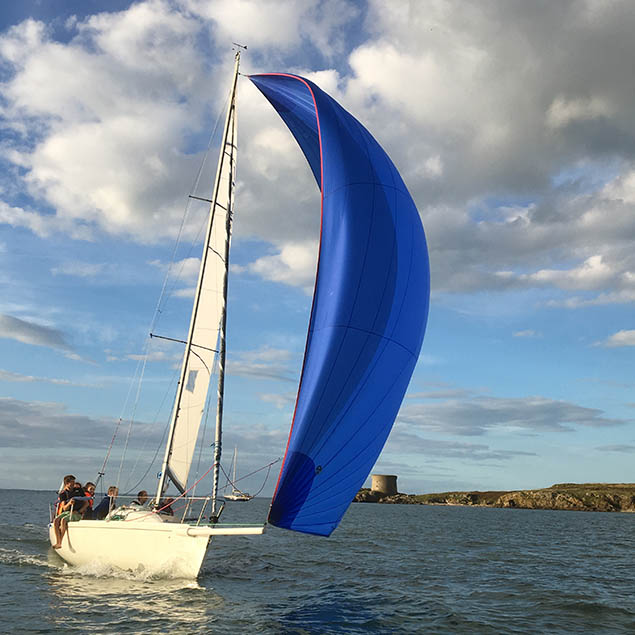
Thanks to the usual useful contacts, the boats were road-trailed to Fishguard and popped on the ferry to be taken across channel on their own to Rosslare. There, another key contact made sure they were taken safely off the ship and put in secure storage while a volunteer towing team co-ordinated by Ian Malcolm journeyed up and down the M11 from Howth until all the boats were safely on the peninsula to successfully complete a project in a league of its own for sheer value for money.
Which is fine and dandy, but the boats need to be used, and used for a lot for multiple purposes, to make this extraordinary example of club and voluntary effort worthwhile, and worthy too of the Sports Council’s support. Yet by now total serendipity had set in. Even as the newly-acquired boats were being checked over and rigged by the flotilla’s newly-appointed bo’sun Luke Malcolm, the news from the Olympic sailing in Rio got better and better. Suddenly thanks to Annalise Murphy and her team-mates, the sun was shining on Irish sailing, and there was no better time to be launching a new initiative in sailing promotion. While there’d been some concern that moving up to five boats from the projected four was maybe a bit ambitious, now people were wondering would five boats be enough.
The day after the fantastic Annalise Murphy “Welcome Home” night at the National Yacht Club, across Dublin Bay on Friday August 26th, beyond the Baily Lighthouse round in Howth Harbour the new five-strong flotilla of Howth YC’s own J/80s were in final preparation for their introduction to the membership and public with an Open Evening providing many immediate options for sailing aboard the boats. It was primarily designed with the club’s rapidly growing beginner and junior sections in mind, and as one of those perfect evenings which have blessed the late summer, it showed how well the performance-oriented J/80s lend themselves to simply being used as fun boats which can maximise the numbers getting afloat for straightforward sailing pleasure.
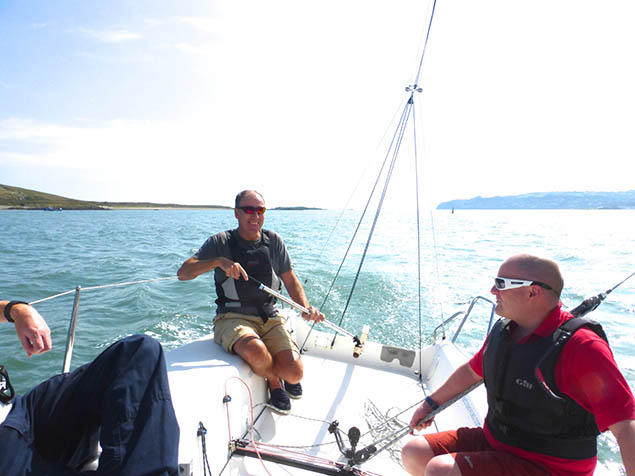
It also underlined the fact that at Howth as at other clubs, people such as Kieran Jameson and noted instructor Graeme Grant share the concern of leading thinkers in other clubs, that it has been too easy to let junior training and coaching take the more easily-managed route of single-handed sailing. Thus Howth has become a centre of 420 encouragement in the hope of leading on to more advanced two-handed boats, and while the J/80s were making their debut with waves of youngsters on board, on the same waters the current World 420 Bronze Medallists Doug Elmes and Colin O’Sullivan were having their first forays with their newly-acquired 49er skiff, one of a new national wave of seven 49ers with crews drawn from a number of Irish sailing centres.
But primarily it was the J/80s’ evening, and they performed with style. With the weather co-operating, the programme moved jauntily on into a junior party with early supper in the club, and then finally, with a very informally-minded audience made up of every age and interest in Howth sailing, the plans for “our very own J/80s” were at last officially revealed by Commodore Berchmans Gannon and his team.
Noted offshore racing champion Ross McDonald, as Chairman of the HYC Performance Sub-committee, left us in no doubt that while the multi-functional uses of the J/80s are significant in the new flotilla’s programme, the boats’ performance potential is also another pillar of their activities, and they’re going to be very actively raced, with their first major series the up-coming Howth Autumn League. The possibilities of sending a boat or two to major J/80 championships in the future has not been overlooked, and of course next year’s ICRA Nats at Royal Cork Yacht Club from 9th to 11th June to will be another option thanks to those very useful IRC Certs.
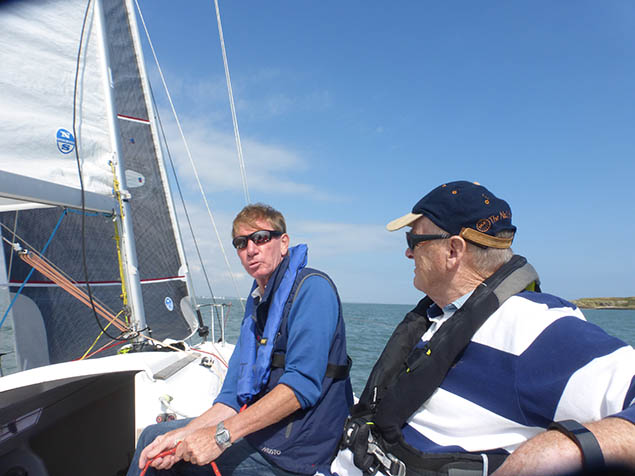
It seems an awful lot to be asking of a little fleet of five 26ft boats, but the best way to show me why it could all work very well indeed was to let me sail a J/80 on Sunday, when all was revealed. The secret of a J/80’s appeal seems to lie in the fact that she’s a boat of broad-spectrum performance and function aboard which kids feel like grown-ups, while a group of grown men start behaving like a pack of schoolboys having sailing fun.
My four ship-mates were at the heavy-hitter end of sailing’s local and national sailing administrations. They included former ICRA Commodore Nobby Reilly who has unrivalled experience in using the J/80s in Try Sailing events – he regularly gets turnouts of upwards of 80 total newbies at such happenings – there was also HYC Vice Commodore Emmet Dalton who somehow finds himself to be the owner of a foiling Moth and the skipper of a Howth 17, there was of course Kieran Jameson whose devotion to sailing and it development and promotion is lifelong, and there was also former HYC Commodore Brian Turvey who has been the club’s liaison man in handling relations with the ISA SailFleet administration while coming to the conclusion that the only way forward was for Howth to buy its own fleet of J/80s to give the programme an extra and vital element of direct proprietorial pride, something which has been achieved.
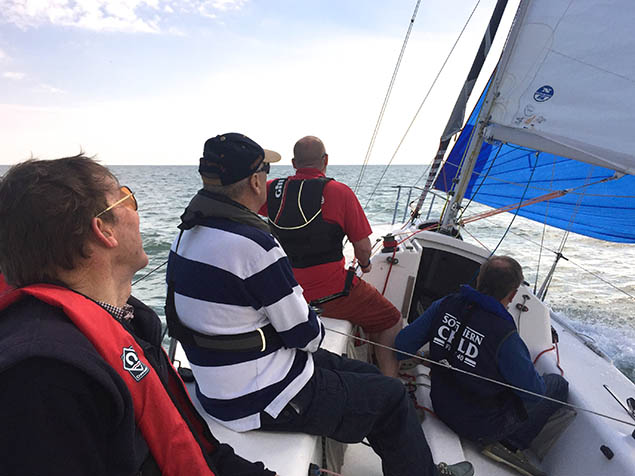
So in sailing “our” J/80 in a glorious burst of sunshine and a grand little north to nor’east breeze last Sunday while the HYC Junior Dinghy regatta with 90 boats in several classes proceeded apace nearby, and Doug Elmes and Colin O’Sullivan buzzed over the ocean towards the northern horizon in their 49er, we had ourselves a ball. While you can certainly get sensational speeds out of a J/80 when the breeze is stonking, we’d no bother in that pleasant moderate wind of finding 7.6 knots through the water with genniker set, and as that translated into 8.7 SOG thanks to a favourable tide, the schoolboy glee was much in evidence between sessions of serious information exchange about the importance of the boat in Howth’s development programe.
In such sailing conditions, the J/80’s effortless progress made it possible for us to get quicky up to Malahide and then have some sport carrying the genniker as close as it could go to get us round Ireand’s Eye where the gannets are more crowded than ever on the Stack, and back into Howth Marina with the J/80s manoeuvring capacities being demonstrated with a flourish.
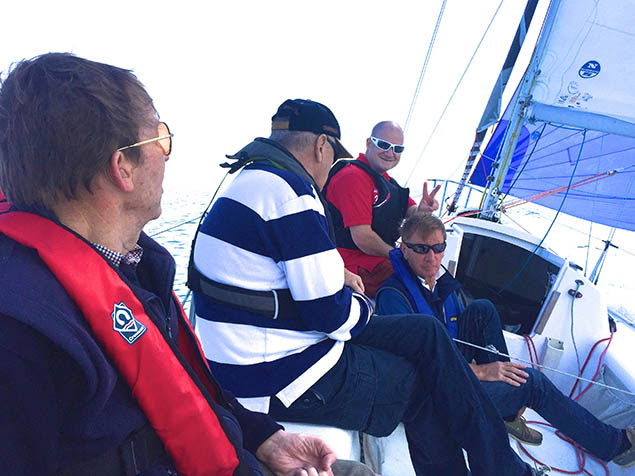
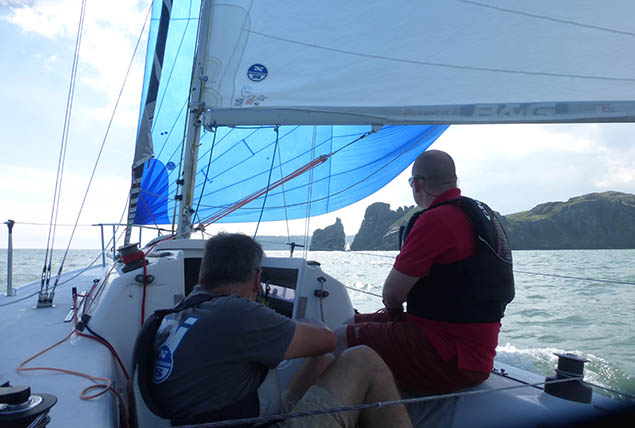
Of course, it won’t always be a sunny nor’easterly of very manageable strength, and it won’t always be a time when a club can look back on its own good season while sharing the national mood of euphoria over an Olympic Sailing Silver Medal. But this new J/80 project at Howth has a lot going for it. And when you start looking at the figures which would have come up if they’d ordered new boats, or maybe even new J/70s, through the formal channels, you’re very quickly getting away from €100,000 for five boats, and approaching the region of a quarter million euros.
But for the times that are in it, it seems that Howth took the best approach. In fact, when the boats are going to have such a multi-functional role, it’s surely better to start with the best second-hand boat available rather than a brand new one. When knockabout use is part of the programme, evidence of the occasional little scape or minor bump makes the boats seem less daunting.
So in all, it has been a very good six weeks of voluntary work. But out in Howth, they don’t see it that way. As far as they’re concerned, the work is only beginning. If those boats aren’t all being kept very busy, steps will be taken immediately to accelerate the pace.
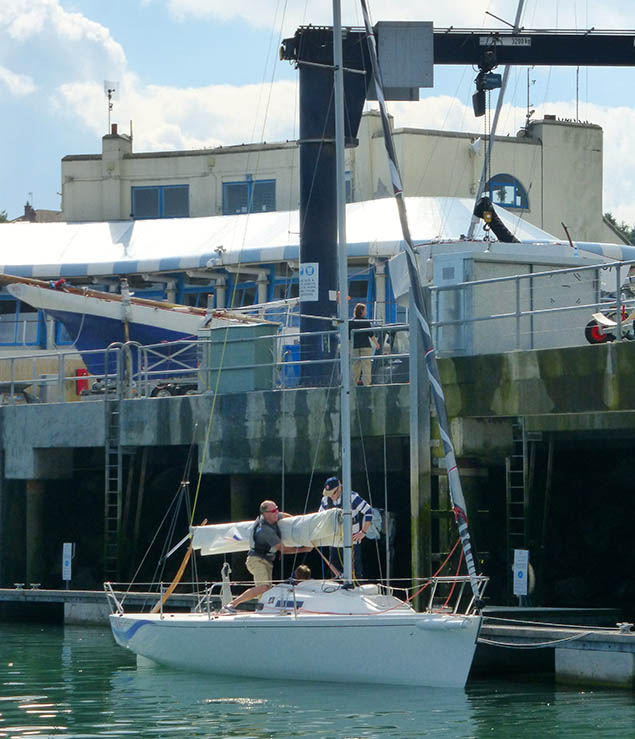 Home port, and everyone gives a hand. Former HYC Commodore Brian Turvey and former ICRA Commodore Nobby Reilly stow the J/80’s mainsail while above on the forecourt the presence of the 1898-built Howth 17 Rita is a reminder of HYC’s long and colourful history. Photo: W M Nixon
Home port, and everyone gives a hand. Former HYC Commodore Brian Turvey and former ICRA Commodore Nobby Reilly stow the J/80’s mainsail while above on the forecourt the presence of the 1898-built Howth 17 Rita is a reminder of HYC’s long and colourful history. Photo: W M Nixon



























